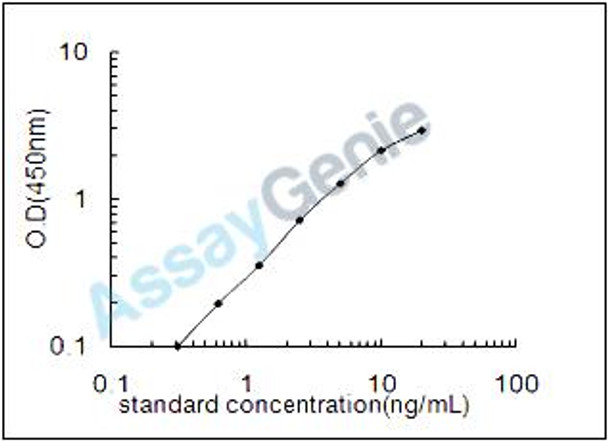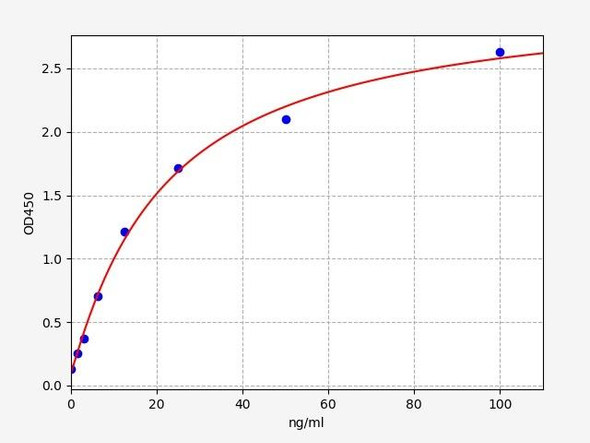Human Cyclic AMP-dependent transcription factor ATF-2 (ATF2) ELISA Kit (HUEB2568)
- SKU:
- HUEB2568
- Product Type:
- ELISA Kit
- Size:
- 96 Assays
- Uniprot:
- P15336
- ELISA Type:
- Sandwich
- Synonyms:
- ATF-2
- Reactivity:
- Human
Description
Human Cyclic AMP-dependent transcription factor ATF-2 (ATF2) ELISA Kit
The Human cAMP-Dependent Transcription Factor ATF-2 (ATF2) ELISA Kit is a reliable tool for accurately measuring ATF2 levels in human samples such as serum, plasma, and cell culture supernatants. This kit offers high sensitivity and specificity, ensuring precise and consistent results for a variety of research applications.ATF2 is a key transcription factor that plays a crucial role in gene expression regulation in response to cAMP signaling. It is involved in various cellular processes including cell survival, proliferation, and differentiation.
Dysregulation of ATF2 has been linked to diseases such as cancer, inflammatory disorders, and neurological conditions.By using the Human cAMP-Dependent Transcription Factor ATF-2 (ATF2) ELISA Kit, researchers can gain valuable insights into the role of ATF2 in disease pathways and potentially discover new therapeutic targets. This kit provides a simple and efficient way to study ATF2 levels in human samples, making it an essential tool for biomedical research.
| Product Name: | Human Cyclic AMP-dependent transcription factor ATF-2 (ATF2) ELISA Kit |
| SKU: | HUEB2568 |
| Size: | 96T |
| Target: | Human Cyclic AMP-dependent transcription factor ATF-2 (ATF2) |
| Synonyms: | Activating transcription factor 2, Cyclic AMP-responsive element-binding protein 2, HB16, Histone acetyltransferase ATF2, cAMP response element-binding protein CRE-BP1, CREB-2, cAMP-dependent transcription factor ATF-2, CREB2, CREBP1 |
| Assay Type: | Sandwich |
| Detection Method: | ELISA |
| Reactivity: | Human |
| Detection Range: | 0.312-20ng/mL |
| Sensitivity: | 0.12ng/mL |
| Intra CV: | 5.4% | ||||||||||||||||||||
| Inter CV: | 9.6% | ||||||||||||||||||||
| Linearity: |
| ||||||||||||||||||||
| Recovery: |
| ||||||||||||||||||||
| Function: | Transcriptional activator which regulates the transcription of various genes, including those involved in anti-apoptosis, cell growth, and DNA damage response. Dependent on its binding partner, binds to CRE (cAMP response element) consensus sequences (5'-TGACGTCA-3') or to AP-1 (activator protein 1) consensus sequences (5'-TGACTCA-3'). In the nucleus, contributes to global transcription and the DNA damage response, in addition to specific transcriptional activities that are related to cell development, proliferation and death. In the cytoplasm, interacts with and perturbs HK1- and VDAC1-containing complexes at the mitochondrial outer membrane, thereby impairing mitochondrial membrane potential, inducing mitochondrial leakage and promoting cell death. The phosphorylated form (mediated by ATM) plays a role in the DNA damage response and is involved in the ionizing radiation (IR)-induced S phase checkpoint control and in the recruitment of the MRN complex into the IR-induced foci (IRIF). Exhibits histone acetyltransferase (HAT) activity which specifically acetylates histones H2B and H4 in vitro. In concert with CUL3 and RBX1, promotes the degradation of KAT5 thereby attenuating its ability to acetylate and activate ATM. Can elicit oncogenic or tumor suppressor activities depending on the tissue or cell type. |
| Uniprot: | P15336 |
| Sample Type: | Serum, plasma, tissue homogenates, cell culture supernates and other biological fluids |
| Specificity: | Natural and recombinant human Cyclic AMP-dependent transcription factor ATF-2 |
| Sub Unit: | Binds DNA as a dimer and can form a homodimer in the absence of DNA. Can form a heterodimer with JUN. Heterodimerization is essential for its transcriptional activity. Interacts with SMAD3 and SMAD4. Binds through its N-terminal region to UTF1 which acts as a coactivator of ATF2 transcriptional activity. Interacts with the HK1/VDAC1 complex. Interacts with NBN, MRE11, XPO1, KAT5 and CUL3. |
| Research Area: | Immunology |
| Subcellular Location: | Nucleus Cytoplasm Mitochondrion outer membrane Shuttles between the cytoplasm and the nucleus and heterodimerization with JUN is essential for the nuclear localization. Localization to the cytoplasm is observed under conditions of cellular stress and in disease states. Localizes at the mitochondrial outer membrane in response to genotoxic stress. Phosphorylation at Thr-52 is required for its nuclear localization and negatively regulates its mitochondrial localization. Co-localizes with the MRN complex in the IR-induced foci (IRIF). |
| Storage: | Please see kit components below for exact storage details |
| Note: | For research use only |
| UniProt Protein Function: | ATF-2: a transcription factor that is a member of the leucine zipper family. Binds to the cAMP-responsive element (CRE). Forms a homodimer or heterodimer with c-Jun and stimulates CRE-dependent transcription. Also possesses histone acetyltransferase (HAT) activity that specifically acetylates histones H2B and H4 in vitro. |
| UniProt Protein Details: | Protein type:EC 2.3.1.48; Transcription factor; C2H2-type zinc finger protein Chromosomal Location of Human Ortholog: 2q32 Cellular Component: nucleoplasm; mitochondrial outer membrane; cytoplasm; nucleus Molecular Function:RNA polymerase II transcription factor activity, enhancer binding; protein binding; histone acetyltransferase activity; protein heterodimerization activity; metal ion binding; cAMP response element binding protein binding; transcription coactivator activity; chromatin binding; transcription factor activity; protein kinase binding Biological Process: fat cell differentiation; transcription from RNA polymerase II promoter; establishment and/or maintenance of chromatin architecture; MyD88-independent toll-like receptor signaling pathway; stress-activated MAPK cascade; toll-like receptor 3 signaling pathway; positive regulation of transforming growth factor-beta2 production; response to osmotic stress; toll-like receptor 2 signaling pathway; toll-like receptor 10 signaling pathway; MyD88-dependent toll-like receptor signaling pathway; toll-like receptor 5 signaling pathway; regulation of transcription from RNA polymerase II promoter; regulation of transcription, DNA-dependent; regulation of transcription factor activity; intra-S DNA damage checkpoint; toll-like receptor signaling pathway; innate immune response; positive regulation of transcription from RNA polymerase II promoter; positive regulation of transcription factor activity; histone acetylation; toll-like receptor 9 signaling pathway; response to DNA damage stimulus; toll-like receptor 4 signaling pathway |
| NCBI Summary: | This gene encodes a transcription factor that is a member of the leucine zipper family of DNA binding proteins. The encoded protein has been identified as a moonlighting protein based on its ability to perform mechanistically distinct functions This protein binds to the cAMP-responsive element (CRE), an octameric palindrome. It forms a homodimer or a heterodimer with c-Jun and stimulates CRE-dependent transcription. This protein is also a histone acetyltransferase (HAT) that specifically acetylates histones H2B and H4 in vitro; thus it may represent a class of sequence-specific factors that activate transcription by direct effects on chromatin components. The encoded protein may also be involved in cell's DNA damage response independent of its role in transcriptional regulation. Several alternatively spliced transcript variants have been found for this gene [provided by RefSeq, Jan 2014] |
| UniProt Code: | P15336 |
| NCBI GenInfo Identifier: | 215274241 |
| NCBI Gene ID: | 1386 |
| NCBI Accession: | P15336.4 |
| UniProt Secondary Accession: | P15336,Q13000, Q3B7B7, Q4ZFU9, Q53RY2, Q8TAR1, A1L3Z2 A4D7U4, A4D7U5, A4D7V1, D3DPE9, G8JLM5, |
| UniProt Related Accession: | P15336 |
| Molecular Weight: | 505 |
| NCBI Full Name: | Cyclic AMP-dependent transcription factor ATF-2 |
| NCBI Synonym Full Names: | activating transcription factor 2 |
| NCBI Official Symbol: | ATF2 |
| NCBI Official Synonym Symbols: | HB16; CREB2; TREB7; CREB-2; CRE-BP1 |
| NCBI Protein Information: | cyclic AMP-dependent transcription factor ATF-2; histone acetyltransferase ATF2; cAMP-dependent transcription factor ATF-2; cAMP-responsive element-binding protein 2; cAMP response element-binding protein CRE-BP1; cyclic AMP-responsive element-binding protein 2; cAMP responsive element binding protein 2, formerly; activating transcription factor 2 splice variant ATF2-var2 |
| UniProt Protein Name: | Cyclic AMP-dependent transcription factor ATF-2 |
| UniProt Synonym Protein Names: | Activating transcription factor 2; Cyclic AMP-responsive element-binding protein 2; CREB-2; cAMP-responsive element-binding protein 2; HB16; Histone acetyltransferase ATF2; cAMP response element-binding protein CRE-BP1 |
| Protein Family: | Alcohol O-acetyltransferase |
| UniProt Gene Name: | ATF2 |
| UniProt Entry Name: | ATF2_HUMAN |
| Component | Quantity (96 Assays) | Storage |
| ELISA Microplate (Dismountable) | 8×12 strips | -20°C |
| Lyophilized Standard | 2 | -20°C |
| Sample Diluent | 20ml | -20°C |
| Assay Diluent A | 10mL | -20°C |
| Assay Diluent B | 10mL | -20°C |
| Detection Reagent A | 120µL | -20°C |
| Detection Reagent B | 120µL | -20°C |
| Wash Buffer | 30mL | 4°C |
| Substrate | 10mL | 4°C |
| Stop Solution | 10mL | 4°C |
| Plate Sealer | 5 | - |
Other materials and equipment required:
- Microplate reader with 450 nm wavelength filter
- Multichannel Pipette, Pipette, microcentrifuge tubes and disposable pipette tips
- Incubator
- Deionized or distilled water
- Absorbent paper
- Buffer resevoir
*Note: The below protocol is a sample protocol. Protocols are specific to each batch/lot. For the correct instructions please follow the protocol included in your kit.
Allow all reagents to reach room temperature (Please do not dissolve the reagents at 37°C directly). All the reagents should be mixed thoroughly by gently swirling before pipetting. Avoid foaming. Keep appropriate numbers of strips for 1 experiment and remove extra strips from microtiter plate. Removed strips should be resealed and stored at -20°C until the kits expiry date. Prepare all reagents, working standards and samples as directed in the previous sections. Please predict the concentration before assaying. If values for these are not within the range of the standard curve, users must determine the optimal sample dilutions for their experiments. We recommend running all samples in duplicate.
| Step | |
| 1. | Add Sample: Add 100µL of Standard, Blank, or Sample per well. The blank well is added with Sample diluent. Solutions are added to the bottom of micro ELISA plate well, avoid inside wall touching and foaming as possible. Mix it gently. Cover the plate with sealer we provided. Incubate for 120 minutes at 37°C. |
| 2. | Remove the liquid from each well, don't wash. Add 100µL of Detection Reagent A working solution to each well. Cover with the Plate sealer. Gently tap the plate to ensure thorough mixing. Incubate for 1 hour at 37°C. Note: if Detection Reagent A appears cloudy warm to room temperature until solution is uniform. |
| 3. | Aspirate each well and wash, repeating the process three times. Wash by filling each well with Wash Buffer (approximately 400µL) (a squirt bottle, multi-channel pipette,manifold dispenser or automated washer are needed). Complete removal of liquid at each step is essential. After the last wash, completely remove remaining Wash Buffer by aspirating or decanting. Invert the plate and pat it against thick clean absorbent paper. |
| 4. | Add 100µL of Detection Reagent B working solution to each well. Cover with the Plate sealer. Incubate for 60 minutes at 37°C. |
| 5. | Repeat the wash process for five times as conducted in step 3. |
| 6. | Add 90µL of Substrate Solution to each well. Cover with a new Plate sealer and incubate for 10-20 minutes at 37°C. Protect the plate from light. The reaction time can be shortened or extended according to the actual color change, but this should not exceed more than 30 minutes. When apparent gradient appears in standard wells, user should terminatethe reaction. |
| 7. | Add 50µL of Stop Solution to each well. If color change does not appear uniform, gently tap the plate to ensure thorough mixing. |
| 8. | Determine the optical density (OD value) of each well at once, using a micro-plate reader set to 450 nm. User should open the micro-plate reader in advance, preheat the instrument, and set the testing parameters. |
| 9. | After experiment, store all reagents according to the specified storage temperature respectively until their expiry. |
When carrying out an ELISA assay it is important to prepare your samples in order to achieve the best possible results. Below we have a list of procedures for the preparation of samples for different sample types.
| Sample Type | Protocol |
| Serum | If using serum separator tubes, allow samples to clot for 30 minutes at room temperature. Centrifuge for 10 minutes at 1,000x g. Collect the serum fraction and assay promptly or aliquot and store the samples at -80°C. Avoid multiple freeze-thaw cycles. If serum separator tubes are not being used, allow samples to clot overnight at 2-8°C. Centrifuge for 10 minutes at 1,000x g. Remove serum and assay promptly or aliquot and store the samples at -80°C. Avoid multiple freeze-thaw cycles. |
| Plasma | Collect plasma using EDTA or heparin as an anticoagulant. Centrifuge samples at 4°C for 15 mins at 1000 × g within 30 mins of collection. Collect the plasma fraction and assay promptly or aliquot and store the samples at -80°C. Avoid multiple freeze-thaw cycles. Note: Over haemolysed samples are not suitable for use with this kit. |
| Urine & Cerebrospinal Fluid | Collect the urine (mid-stream) in a sterile container, centrifuge for 20 mins at 2000-3000 rpm. Remove supernatant and assay immediately. If any precipitation is detected, repeat the centrifugation step. A similar protocol can be used for cerebrospinal fluid. |
| Cell culture supernatant | Collect the cell culture media by pipette, followed by centrifugation at 4°C for 20 mins at 1500 rpm. Collect the clear supernatant and assay immediately. |
| Cell lysates | Solubilize cells in lysis buffer and allow to sit on ice for 30 minutes. Centrifuge tubes at 14,000 x g for 5 minutes to remove insoluble material. Aliquot the supernatant into a new tube and discard the remaining whole cell extract. Quantify total protein concentration using a total protein assay. Assay immediately or aliquot and store at ≤ -20 °C. |
| Tissue homogenates | The preparation of tissue homogenates will vary depending upon tissue type. Rinse tissue with 1X PBS to remove excess blood & homogenize in 20ml of 1X PBS (including protease inhibitors) and store overnight at ≤ -20°C. Two freeze-thaw cycles are required to break the cell membranes. To further disrupt the cell membranes you can sonicate the samples. Centrifuge homogenates for 5 mins at 5000xg. Remove the supernatant and assay immediately or aliquot and store at -20°C or -80°C. |
| Tissue lysates | Rinse tissue with PBS, cut into 1-2 mm pieces, and homogenize with a tissue homogenizer in PBS. Add an equal volume of RIPA buffer containing protease inhibitors and lyse tissues at room temperature for 30 minutes with gentle agitation. Centrifuge to remove debris. Quantify total protein concentration using a total protein assay. Assay immediately or aliquot and store at ≤ -20 °C. |
| Breast Milk | Collect milk samples and centrifuge at 10,000 x g for 60 min at 4°C. Aliquot the supernatant and assay. For long term use, store samples at -80°C. Minimize freeze/thaw cycles. |









